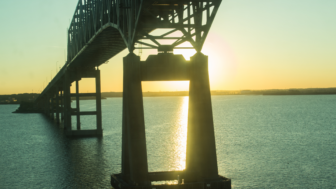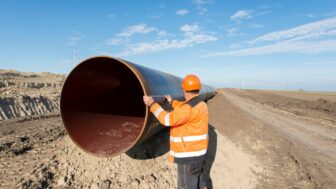December 11, 2013
Mr. Daniel A. Weekley
Vice President – Government Affairs
Dominion Resources
120 Tredegar St.
Richmond, VA 23219
Dear Mr. Weekley,
I am in receipt of you letter dated November 25, 2013. Please find below a point-by-point response to the issues that you raised. Given the very large scope of your $3.8 billion proposal to liquefy gas from hydraulic fracking and ship it to Asia via the Chesapeake Bay, we continue to regret Dominion’s resistance to conducting a standard Environmental Impact Statement. This resistance to a customary federal EIS, perhaps above all else, has become a widespread and deep concern among many, many Marylanders.
My response to your letter:
Gas Exports Would Harm Most Sectors of the U.S. Economy
- The U.S. Department of Energy found that nearly all the benefits of LNG exports would be concentrated toward a few economic actors within the gas industry and its attendant supply chain while everyone else essentially loses. In fact, DOE concluded that LNG exports would bring “net economic benefits to the United States” only because the increases in natural gas profits would be slightly big enough to mask the drags on GDP caused by billions of dollars in lost labor wages, decreased capital income, and increased tax burdens across the economy due in large part to increased domestic gas prices. America’s Energy Advantage – a business coalition of manufacturers – has warned that increased domestic gas prices brought on by increased exports could “erode our country’s competitive advantage, threatening to stall the great manufacturing resurgence that is just beginning to bring significant benefits to the U.S. economy.” These concerns have been compounded by the fact that DOE warned that domestic gas prices could increase by up to $1.11/MMbtu in 2020 – 27 percent higher than where gas prices would otherwise be in 2020 – while an independent analysis by Charles River Associates found that natural gas prices could almost triple by 2030 with higher demand and LNG Exports.
Clean Energy Would Bring More Jobs than Exporting Fracked Gas
- Cove Point would cause a short-term increase of construction jobs in Calvert County. However, after the three-year construction period, Cove Point would hire mostly non-local workers to fill highly-specialized permanent positions, while increased LNG exports would hurt U.S. job growth by increasing domestic energy prices. By contrast, strong renewable energy policies sustain thousands of construction jobs over a much longer period of time, and they also promote long-term U.S. competitiveness by lowering local electricity prices, advancing energy independence, and providing opportunities for innovation in a growing industry. Simply doubling Maryland’s solar carve-out from 2% by 2020 to 4% by 2025, for example, would sustain almost 3,000 temporary jobs each year between now and 2025 and support almost 300 permanent jobs in 2025, according to the National Renewable Energy Laboratory’s Jobs and Economic Development Impact Model.
If Constructed, the Cove Point LNG Export Facility Would be the 4th Largest Climate Polluter in Maryland
- Dominion is applying for a Certificate of Public Convenience and Necessity (CPCN) with the MD Public Service Commission (PSC) and is requesting a permitted greenhouse gas emissions threshold of 3.3 million tons. Since you believe that those numbers are inflated, we suggest that that Dominion revise its application with the PSC to reflect more accurate emission estimates. However, even at the lower emissions level of 2 million tons of CO2e per year, which you indicate is a more accurate projection for what the facility would emit; Cove Point would still be the 4th largest climate polluter in Maryland. The next largest emitter in Maryland is the 205 megawatt coal-fired power plant – AES Warrior Run – in Cumberland, which emitted 1.5 million tons of CO2 in 2012.
This Project Would Increase Tanker Traffic in Cove Point by 549% Over the Levels Seen in the Last Four Years
- From 2008 – 2011, the last four years for which data is available, Cove Point imported roughly 39,000 million cubic feet of gas per year, which is the equivalent of about 13 ships per year. So even though Dominion is not requesting a modification to its permitted shipping limits, the fact remains that 85 ships per year would be a huge increase in tanker traffic for Cove Point.
- Furthermore, Marylanders are very concerned about the impacts that these ships would have on the Chesapeake Bay. According to University of Maryland’s Dr. Mario Tamburri, each ship arriving at Cove Point will discharge between 16 and 25 million gallons of ballast water into the Chesapeake Bay each year. As of yet, the U.S. Coast Guard “has yet to certify that any ballast water management system meets the U.S. discharge regulations and is acceptable for use.” Dr. Tamburri goes on to note that even if the ballast water does meet federal regulations, those standards “will not eliminate the serious threat of invasive species… there [also] will still be significant human health concerns that must be considered if these enormous volumes of ballast water are to be released.” These risks include the release of strains of cholera, toxic algae, and radioactive water in the Bay. To date, Dominion has not addressed these concerns.
Cove Point Project Would Bring More Pipelines and Other Infrastructure
- It is almost certain that new infrastructure would be needed to export 770 million cubic feet of natural gas per day, or nearly four times the daily consumption of all Maryland households. That is because the Interstate Natural Gas Association of America (INGAA) recently reported that 1,400 miles of new transmission pipelines will be necessary in the future to connect shale gas with increasing demand areas. LNG exports are a temporary “market mover” driving new infrastructure demand, and Cove Point is one of only two proposed export terminals on the East Coast. As for the Myersville, Md. compressor station, only 115,000 Dth/d from that project is contracted to Washington Gas Light Company and Baltimore Gas & Electric for delivery. The 16,000-horsepower station would be able to handle a much higher capacity of gas. According to attorneys involved in the Myersville case, the information submitted to FERC but not accessible to the general public (due to restrictions on “critical energy infrastructure information”) indicates excess capacity will be transported to Cove Point. If you wish to assure the people of Myersville that your proposed compressor station will not be used to pipe shale gas to Cove Point, you should consider putting that pledge in writing and providing it to the elected officials of Myersville.
The Fact that Other Export Sites are Being Proposed does not Make LNG Exports a Good Idea for Maryland
- Maryland is a densely populated state with a proud history of environmental protection. Your proposed project rests along the Chesapeake Bay, the lifeblood of Maryland’s thriving tourist and fishing and recreation industries. Marylanders take pride in the Bay and that is why we have spent decades working on restoration and protection projects. We have also set one of the strongest statutory greenhouse gas reduction goals in the country, pledging to reduce emissions by 25 percent by 2020. And finally, the air shed in which you are proposing to build has one of the worst ozone problems east of the Mississippi. Other states can decide what is best for them
, but Maryland should not move forward on this massive project simply because the natural gas industry wants to also export LNG elsewhere.
We are happy that you sent us this letter and we feel that the exchange of accurate data will continue to be needed and welcomed as part of this project. However, as seen in our response above, we continue to feel that you would better serve the people of Maryland by better communicating the diverse range of potential economic and environmental impacts from this proposed project.
With an understanding that there are differing viewpoints about the merits of exporting LNG from Cove Point, I continue to extend a standing invitation to Dominion’s President, Thomas Farrell, to debate me in a public forum so that Marylanders can be better informed about this project. Please find attached that invitation dated November 5, 2013.
Sincerely,
Mike Tidwell
Cc: Gov. Martin O’Malley
Maryland Congressional Delegation
Regional Legislative Delegation
Calvert County Commissioners





